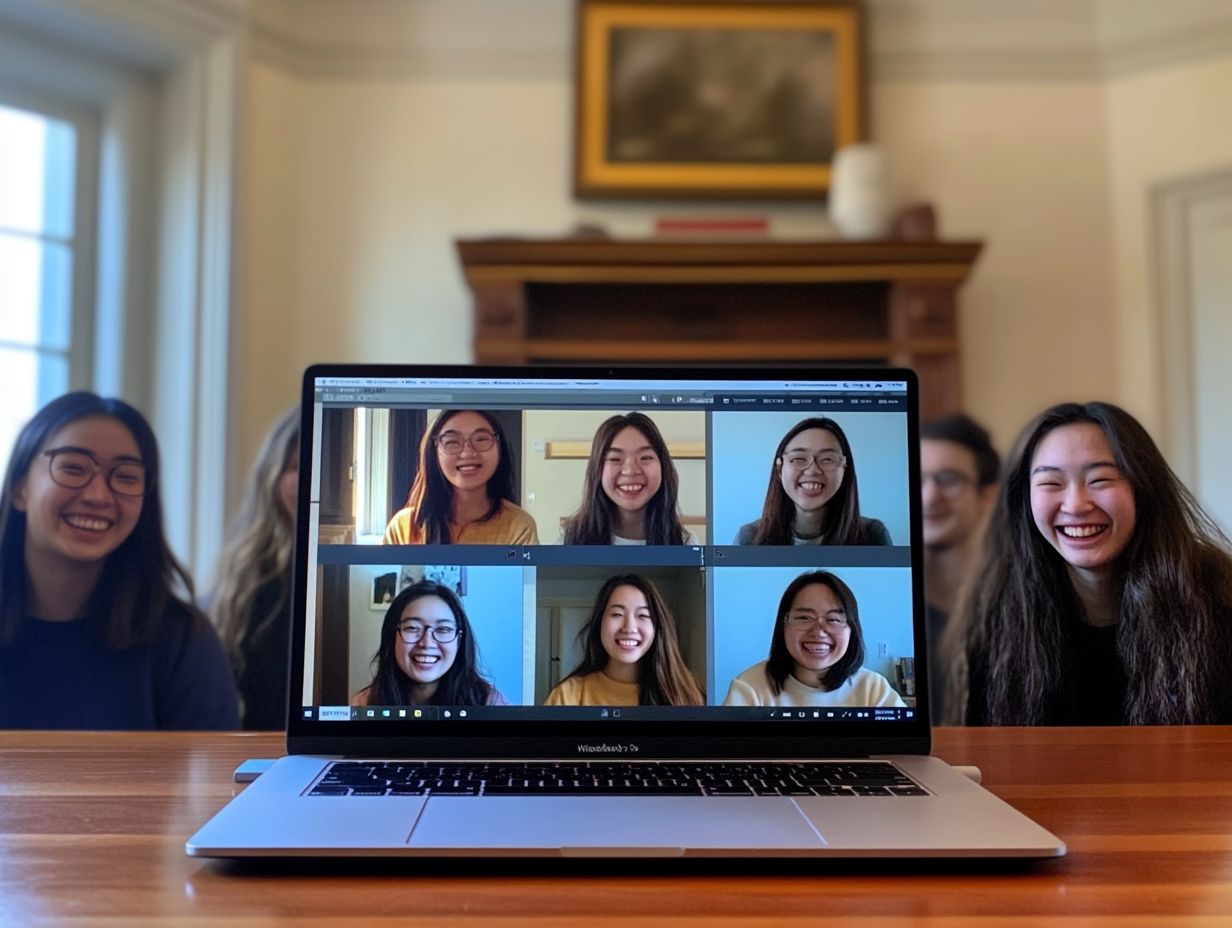What is the Importance of Peer Interaction in Online Learning?
In today s digital age, the world of education has undergone a remarkable transformation, as peer interaction has emerged as a vital component of online learning.
While technology provides you with convenient access to a wealth of information, it s the social connections you forge with fellow students that truly elevate your engagement and enrich your understanding of the material.
This article delves into the myriad benefits of peer interaction, from honing your communication skills to effectively navigating challenges, and offers you practical strategies for cultivating an interactive online environment.
Join us on this exciting journey as we reveal best practices for fostering collaboration and building a nurturing and supportive learning community.
Contents
- Key Takeaways:
- The Role of Peer Interaction in Online Learning
- Benefits of Peer Interaction in Online Learning
- Challenges of Peer Interaction in Online Learning
- Strategies for Facilitating Peer Interaction in Online Learning
- Best Practices for Incorporating Peer Interaction in Online Learning
- Frequently Asked Questions
Key Takeaways:

Peer interaction is crucial in online learning as it promotes social learning and enhances engagement in the learning process. It also allows for the development of important communication and collaboration skills that are essential in today’s workplace. Effective strategies such as creating opportunities for collaboration and utilizing technology can help overcome challenges of peer interaction in online learning.
The Role of Peer Interaction in Online Learning
Peer interaction is crucial in online learning environments, creating a space where first-year students can truly excel both academically and socially.
It boosts student engagement, fosters collaborative learning, and nurtures essential social skills that are vital in academic settings and beyond.
Understanding peer interaction is increasingly important for fostering positive learning outcomes and emotional engagement. This aspect of distance education is especially significant for those facing the challenges of remote learning, as it alleviates feelings of isolation and promotes effective collaboration among students.
Understanding the Importance of Social Learning
Social learning serves as a cornerstone of online education, inviting you to actively engage with your peers to construct knowledge through shared experiences.
This method not only bolsters your social skills but also immerses you in collaborative projects and educational activities that demand teamwork and communication within online classes.
By cultivating a sense of community, this approach resonates with the idea that we learn better by interacting with others, underscoring that knowledge is created together through meaningful interaction.
In your online classroom, the importance of effective teaching presence cannot be overstated; instructors play a vital role in guiding discussions, igniting ideas, and encouraging you to learn from one another.
Consider a group project where you and your classmates share diverse perspectives or a peer review process that sharpens your critical thinking.
These interactions enrich your learning experience and elevate your engagement and satisfaction, making you feel more connected to both your peers and the course material.
Benefits of Peer Interaction in Online Learning
Peer interaction in online learning offers exciting benefits that can greatly elevate both your academic achievement and social development.
By engaging with your peers, you cultivate a sense of community that enhances emotional engagement and motivation, ultimately leading to improved learning outcomes.
Collaborative learning activities enable you to share knowledge, spark critical thinking, and hone the interpersonal skills essential for success in both educational and professional arenas.
Enhanced Learning and Engagement
Enhanced learning and engagement are direct results of effective peer interaction in online education.
When you engage with your peers, you clarify your understanding of the material and strengthen your ability to apply knowledge across various contexts.
This collaborative approach fosters a deeper level of learning, enabling you to challenge perspectives and work through complex problems together.
For instance, in an online course centered on project management, breakout groups can simulate real-world scenarios where you must negotiate tasks and allocate resources.
Such interactive activities not only enhance your comprehension but also build essential soft skills like teamwork and communication.
Platforms that feature discussion forums encourage you to pose questions, respond to your peers, and share diverse viewpoints, creating a rich tapestry of dialogue that promotes critical thinking and sustained interest.
In conclusion, embracing peer interaction in online learning is essential for achieving both academic success and personal growth. By applying these principles, you can create a more engaging and supportive learning environment.
Development of Communication and Collaboration Skills

The development of communication and collaboration skills is one of the standout benefits of peer interaction in online learning environments. When engaging in group work and collaborative projects, you re encouraged to articulate your ideas clearly and work effectively with your peers. This not only enhances your social skills but also prepares you for future professional settings.
Such engagement fosters essential people skills while creating a sense of community among your peers.
Programs like Social Skills Training (SST) and Collaborative Problem Solving (CPS) highlight the importance of active listening, conflict resolution, and empathetic communication skills that are vital for nurturing positive interactions. For example, SST often creates real-life scenarios in a controlled environment, allowing you to practice these skills safely.
These initiatives ensure that you re prepared for academic collaborations and ready to excel in various social contexts, whether in your future workplaces or everyday encounters.
Summary: Peer interaction in online learning helps develop communication skills crucial for academic and professional success.
Challenges of Peer Interaction in Online Learning
While online learning offers many benefits, navigating peer interaction comes with challenges that can hinder effective collaboration and social adjustment.
Negative perceptions of online education may lead to academic struggles, resulting in feelings of isolation and disengagement in digital learning environments. Acknowledging these hurdles is crucial for educational institutions striving to cultivate meaningful peer relationships and improve overall student satisfaction.
Summary: Recognizing and addressing challenges in peer interaction is vital for enhancing student experience in online learning.
Overcoming Barriers to Effective Peer Interaction
Overcoming barriers to effective peer interaction is crucial for your success in remote education settings. By addressing common issues such as communication gaps, lack of engagement, and feelings of isolation, educational institutions can create a collaborative learning environment that promotes academic success.
To achieve this, various strategies can be employed, including the integration of technology solutions like video conferencing tools such as Zoom and interactive platforms like Moodle, which facilitate real-time discussions and group projects.
Institutions can also prioritize building an inclusive online community through virtual support groups and collaboration spaces that encourage your participation.
Successful case studies from various universities that implemented structured peer-feedback systems and online forums have demonstrated significant improvements in student interaction. This leads to increased engagement and better collaborative learning outcomes.
These examples show that with the right approach, barriers to peer interaction can be effectively dismantled, ultimately enriching your educational experience.
Summary: Addressing barriers is key to fostering an engaging and collaborative online learning environment.
Strategies for Facilitating Peer Interaction in Online Learning
Implementing effective strategies to facilitate peer interaction is crucial for cultivating an engaging online learning environment.
You can leverage various tools and techniques to enhance social interaction opportunities among students, fostering a sense of community that contributes significantly to both academic success and student satisfaction.
Summary: Utilize diverse tools and strategies to create an engaging online learning experience.
Creating Opportunities for Collaboration
Creating opportunities for collaboration is crucial for enhancing peer interaction in online education settings. By incorporating group work activities and structured peer learning initiatives, you can cultivate a collaborative atmosphere that encourages deeper engagement with the content and each other.
For instance, implementing virtual study groups or collaborative projects using platforms like Google Docs or discussion boards can significantly elevate interaction levels. Assigning roles within teams clarifies responsibilities and fosters accountability, as students learn to rely on one another for success.
Activities like peer reviews and group presentations enable participants to share diverse perspectives, enriching their overall learning experience.
The beauty of peer learning lies in its power to enhance critical thinking and motivation. This creates a community where students feel supported and enabled to actively contribute to their collective learning journey.
Summary: Foster collaboration through structured activities and tools to enrich the learning experience.
Join a study group today to enhance your learning!
Utilizing Technology for Peer Interaction

Utilizing technology effectively can significantly elevate peer interaction in your online classrooms. By integrating digital tools, you can create interactive activities that foster collaboration among your students.
For instance, platforms like Slack and Microsoft Teams encourage real-time discussions and facilitate group projects. This allows learners to share insights and feedback effortlessly.
Tools such as Padlet and Miro spark creativity by enabling brainstorming sessions in a virtual setting. Everyone has the opportunity to contribute.
Implementing discussion forums and live polling features enhances the learning experience. These provide students with a platform to voice their opinions and engage actively.
These applications promote social interaction and boost academic achievement. They cultivate a sense of community, where learners feel supported and motivated to excel.
Best Practices for Incorporating Peer Interaction in Online Learning
Incorporating peer interaction into online learning takes commitment to best practices. These practices help create a supportive environment.
Building positive relationships and encouraging active participation greatly enhances course satisfaction and engagement.
This thoughtful approach enriches learning and helps everyone thrive in collaboration.
Creating a Positive and Supportive Learning Environment
A positive and supportive learning environment is essential for effective peer interaction. This atmosphere encourages engagement and builds confidence for collaboration.
To create this environment, include key elements like inclusivity, respect, and encouragement. Start by establishing clear communication guidelines to ensure everyone’s voice is heard.
Breakout groups allow for personal connections with classmates and foster a sense of community. Setting clear expectations and providing constructive feedback strengthens mutual respect among students.
Recognizing individual achievements boosts morale and motivates both you and your peers to contribute and support each other throughout the course.
Encouraging Active Participation and Feedback
Encouraging active participation and feedback is key for maximizing peer interaction. When you contribute to discussions and offer constructive feedback, it deepens engagement with the course content.
Promoting active involvement can be done through techniques like breakout rooms for small group discussions. You might also implement peer review systems.
Introduce forums for questions or resource sharing to build a sense of community. Timely feedback, such as group critiques or reflective surveys, motivates connections with peers and refines your thoughts.
These practices create a dynamic online atmosphere that fosters continuous learning and meaningful interactions.
Frequently Asked Questions
What is the Importance of Peer Interaction in Online Learning?

Peer interaction is crucial in online learning. It allows students to engage with each other and learn collaboratively.
How does peer interaction enhance the learning experience?
Peer interaction boosts the learning experience. It promotes active learning, increases motivation, and fosters critical thinking skills.
Examples of Peer Interaction in Online Learning
Peer interaction includes discussion forums, group projects, peer reviews, and virtual study groups.
Building a Community Through Peer Interaction
Connecting with classmates creates a strong community in online learning. Students can share experiences, exchange ideas, and support one another.
Benefits of Peer Interaction
Peer interaction transforms the online learning journey! It helps students develop communication and teamwork skills while gaining new perspectives.
Fostering Peer Interaction
Educators should create opportunities for collaboration and set clear guidelines. Using interactive tools can significantly encourage student engagement.






